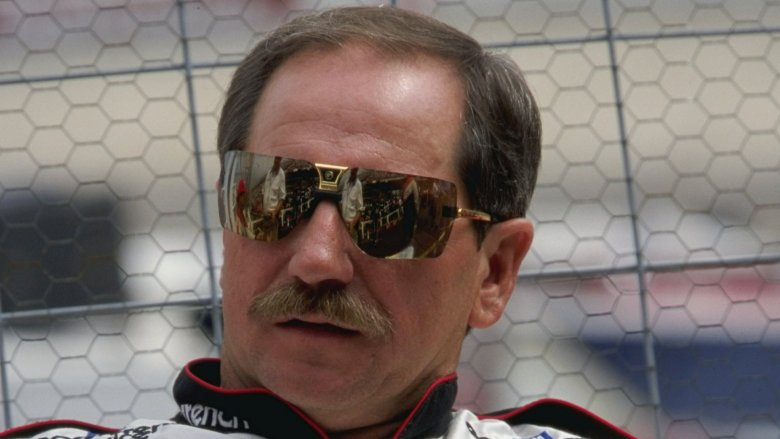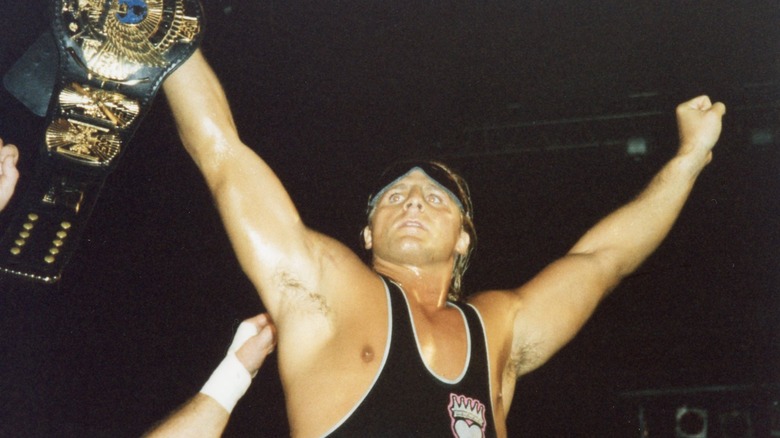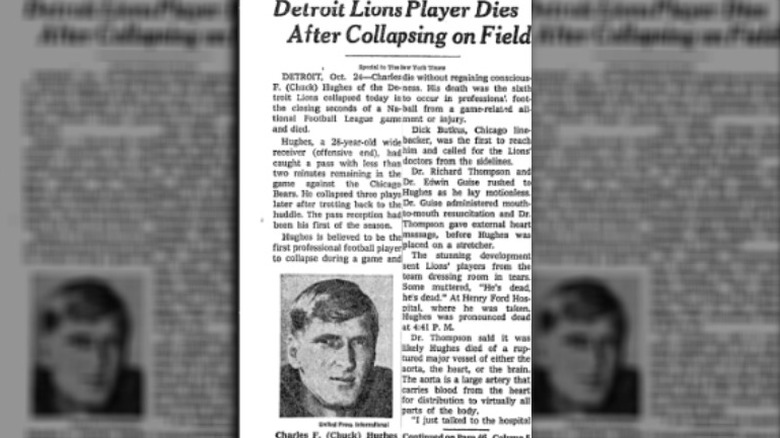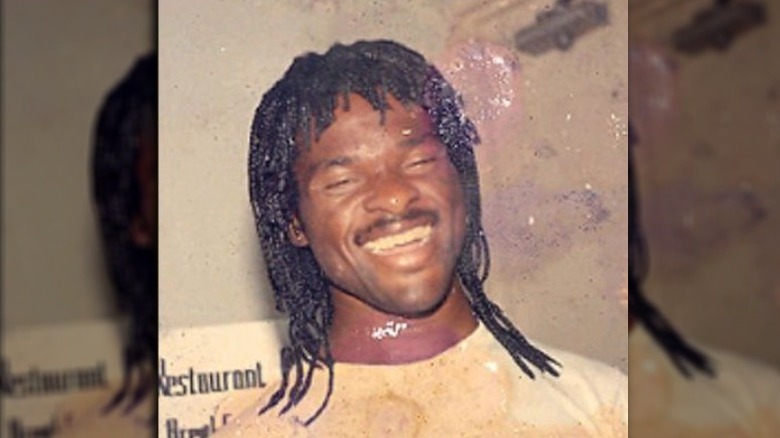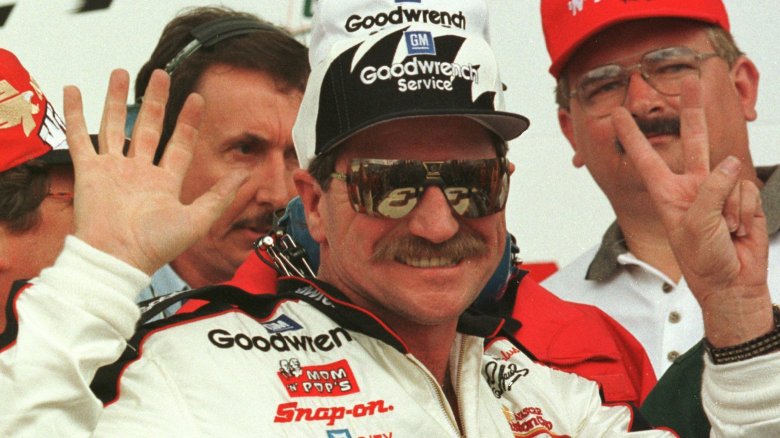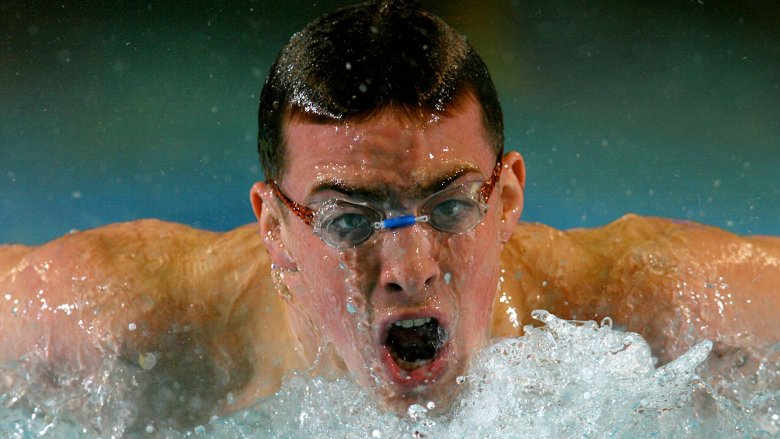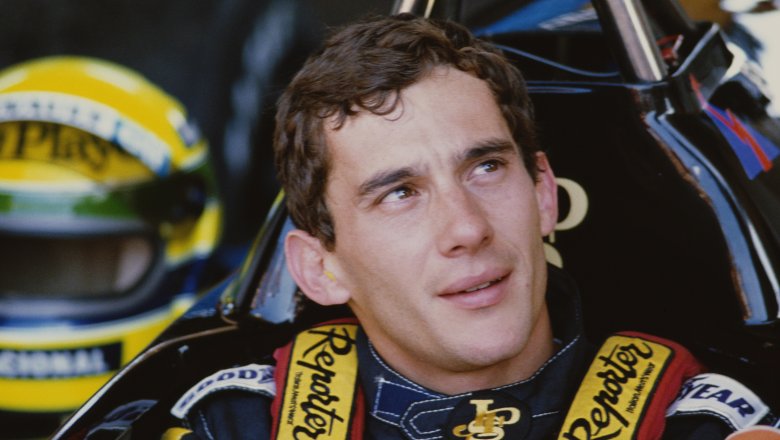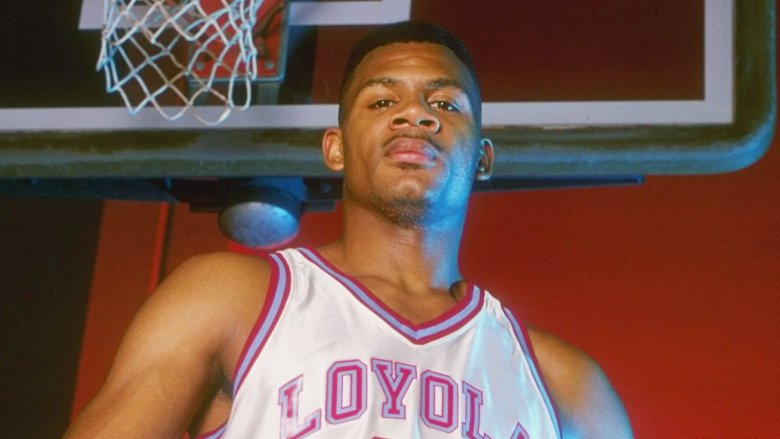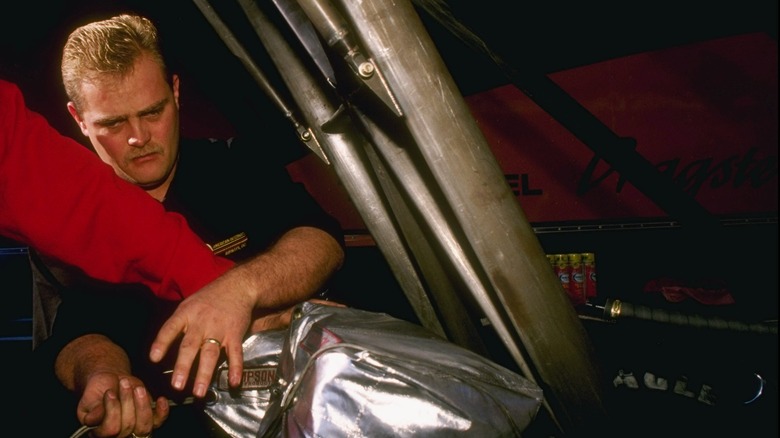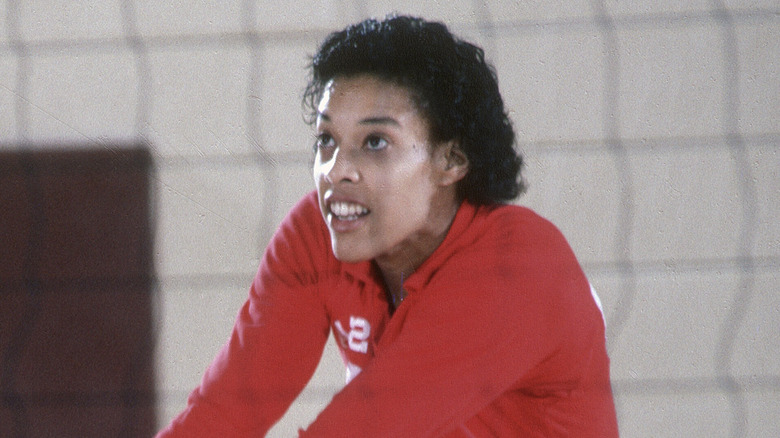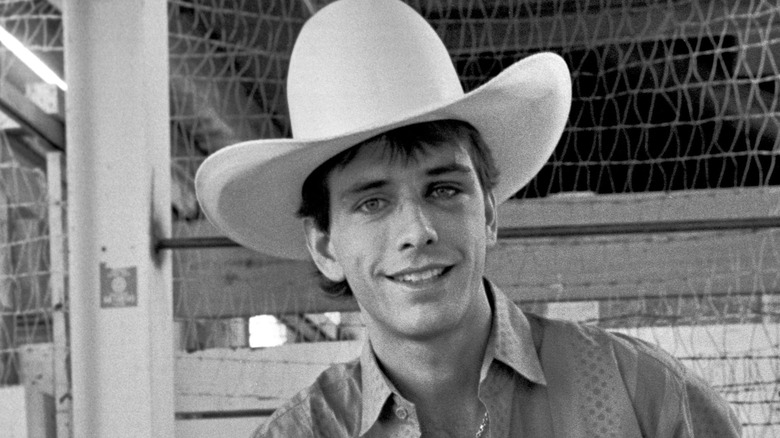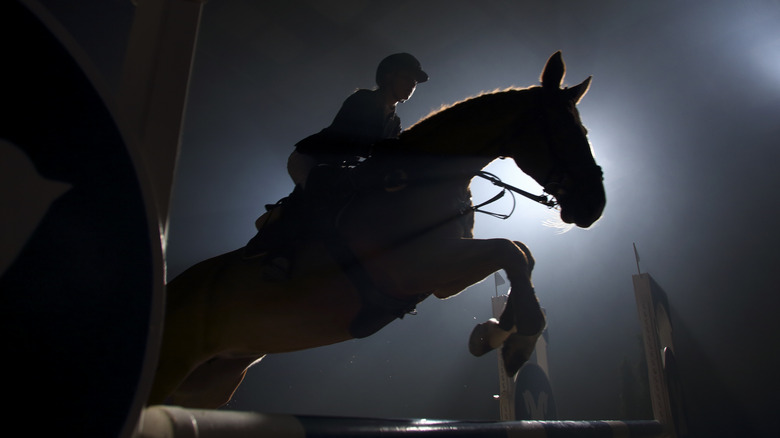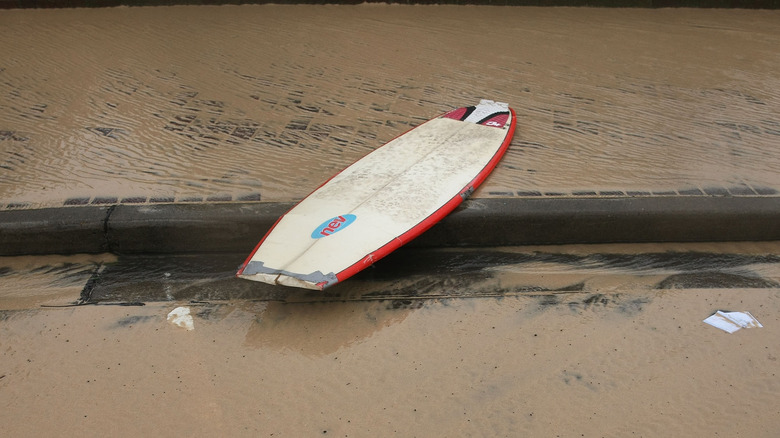Athletes Who Died In Front Of Their Fans
Sports are physically taxing, and only those whose bodies are properly conditioned can find success on a professional level. After all, it's exercise, against and alongside other elite athletes for hours at a time, for months on end (and that doesn't even include training camp). The exertion of sports gets a player's adrenaline pumping and their heart rate up as they go for the gold while also avoiding contact with balls, walls, and other individuals. Almost always, a sporting event goes in the books as both an entertaining event and boastful display of human possibility.
But alas, the body is fallible and frail, even for world class athletes. They can easily get injured, or in the middle of all that intensive activity, they can even succumb to health problems they didn't even know they had. Of the many thousands who have played professional or international sports, a handful have died in the line of duty and in the pursuit of victory. These are the poor souls who passed away while doing what they loved.
Owen Hart
As part of a duo with his brother, Bret "The Hitman" Hart, Canadian wrestler Owen Hart was among the most popular WWE stars of the '90s, a flashy showman who loved to incorporate characters and costumes into his act. Owen Hart was set to appear as an obnoxious superhero for his appearance at "Over the Edge," a May 1999 pay-per-view event held at Kemper Arena in Kansas City, reports CNN. The plan called for Owen, a.k.a. the Blue Blazer, to be slowly lowered into the ring from the rafters with the use of a wire system.
But that's not what happened. The rigging malfunctioned, and Owen plunged some 80 feet into the ring, according to Sportscasting. WWE announcer Jim Ross told the silenced crowd that the fall was not a scripted moment or a stunt. TV viewers didn't see the fall, as the broadcast had cut to a Owen Hart highlight reel before his grand entrance. Barely 34 years old, Owen died within minutes, after his lungs filled with blood due to a severed aorta. He was pronounced dead at a nearby hospital that night.
Chuck Hughes
As a receiver at Texas Western (now the University of Texas at El Paso), Chuck Hughes was amazing. In his second season in 1965, he caught 13 touchdowns and racked up more than 1,600 yards. Hughes' pro career was nondescript, with three seasons as a backup for the Philadelphia Eagles and a couple more in that capacity for the Detroit Lions.
In the fall of 1971, Hughes suffered a heart attack right after a preseason game, collapsing in the locker room, reports Yahoo Sports. Doctors couldn't figure out the source of his stomach and chest pains, and Hughes summarily ignored them, eager to get back to the gridiron. On October 24, 1971, the Lions faced the Bears in Detroit, with Hughes replacing regular Lions receiver Larry Walton as the Bears led 28 to 23 with just a few minutes left to play. Hughes caught a pass, endured a hard hit by Chicago defenders, then got up for a few more plays. After running down the field for a pass that went to another receiver, Hughes headed back to the huddle ... then fell to the turf. Bears linebacker Dick Butkus noticed first and called for help from the sidelines. Doctors couldn't revive him, and neither could anything be done at a hospital. Hughes, 28, died from a what was likely a heart attack triggered by a severely injured spleen.
Sam Okwaraji
Sam Okwaraji left his native Nigeria for Europe to study for his doctorate, but he wound up playing professional soccer, reports the Nigerian Tribune. After suiting up for various European teams in the '80s, Okwaraji returned home to join the Nigerian national team (the Green Eagles) in 1988, and a year later found himself playing in a World Cup qualifier against Angola.
Okwaraji would never take the pitch in the 1990 World Cup, however. Deep into the second half of the qualifier, a referee ejected an Angolan player. While his teammates circled around the official in protest, a few feet away, Okwaraji collapsed to the ground. His teammates rushed over to him, but there was nothing anybody could do — he was already dead. According to an autopsy, the 25-year-old player had died suddenly of an enlarged heart, made all the worse due to high blood pressure. Nigeria won the game but were eliminated from World Cup contention not long after.
Dale Earnhardt Sr.
On paper, high-level auto racing seems extremely dangerous. The sport consists almost entirely of heavy chunks of metal with people sealed inside of them careening around a track at 200 miles per hour. There are numerous safety protocols in place, however, which makes deaths thankfully rare. One major casualty of NASCAR: the 2001 death of Dale Earnhardt, Sr. He's like the Babe Ruth or Joe Montana of his sport — so popular and successful that even people who don't follow NASCAR know the name ... and the tragedy.
Just three years after finally winning his first Daytona 500 in 1998 (via ESPN), Earnhardt raced in the February 2001 edition of the event, one of the premiere and most-watched NASCAR races. Toward the end of the race, Earnhardt's car slammed into a concrete wall at about 180 miles per hour, according to the Orlando Sentinel, killing the legendary "3" immediately. Initially, a NASCAR review held that a malfunctioning seat belt caused Earnhardt to hit his head on the steering wheel, reports Motorsport.com. But when Duke University biomedical engineering professor Dr. Barry Myers reviewed the autopsy and other info, he attested that when Earnhardt hit the wall, his head whipped forward with such intensity that it detached muscles, killing him instantly. In the wake of Earnhardt's death, NASCAR adopted numerous new safety measures, particularly a neck-securing device that prevents such a deadly kind of whiplash.
Fran Crippen
Fran Crippen was a terrific swimmer, an 11-time All-American and the ACC's swimmer of the year while attending the University of Virginia, reports Virginia Sports. In pool swimming events, he scored a bronze medal at the 2001 Goodwill Games and two silvers at the 2003 Pan American Games. He then moved from pool swimming to open water swimming, which is just that — traversing large, naturally occurring bodies of water. He found instant success, winning a silver medal in the 10 kilometer open water event at the 2006 Pan Pacific Championships. A year later, he landed a gold in the 10 kilometer open swim at the Pan American Games, the first of many top finishes in major long-distance water races.
Crippen was a major contender to place in the 2010 10K series presented by FINA (the international swimming body), which finished up in the United Arab Emirates, notes the Los Angeles Times. When Crippen didn't cross the finish line, other swimmers got worried (some had found the water to be uncomfortably hot) and searched for him. A dive team then came in and discovered the swimmer, drowned below the course. According to a FINA report, Crippen, 26, died from a heart abnormality, brought about by "uncontrolled exercise-induced asthma in unfavorable race environmental conditions."
Wouter Weylandt
The Giro d'Italia, or the Tour of Italy, is among Europe's many multi-stage, multi-day bicycle races that send elite riders on a tour across beautiful countryside. It's essentially Italy's version of the famous Tour de France. Belgian racer Wouter Weylandt of the Luxembourg team Leopard Trek had won stages at the similar Tour of Spain in 2008 and at the Giro d'Italia in 2010 before competing in that race's 2011 edition.
The Guardian details that during the third stage, Weylandt wound down the steep, twisty roads of the descent from the Passo del Bocco. About 20 miles from the finish, he lost control and crashed. Some witnesses say he hit a wall; at any rate, he landed hard on his face and bled profusely upon impact. Emergency workers eschewed an ambulance, such was the urgency of treating Weylandt's injuries and tended to the fallen rider where he lay on the road. Weylandt was discovered unconscious with a fracture at the base of his skull, and his heart had stopped. Adrenaline and atropine injections, along with other actions, were unsuccessful. Weylandt, a five-year veteran of the racing circuit with a baby on the way, died at age 26.
Ayrton Senna
Outside of the United States, the dominant type of motorsport is Formula One, with its lucrative grand prix races held on specially built tracks and on public roads. Ayrton Senna was one of the best Formula One drivers ever — just 10 years in the sport, he won a whopping 41 contests, including the Monaco Grand Prix six times, reports Fox Sports. Senna's home nation of Brazil held him up as a hero and a national treasure.
As VICE details, on May 1, 1994, Senna competed in a race on the Imola circuit in Italy, driving his Williams-Renault. Suddenly, when dealing with a left-turn corner at a necessarily high speed, his car suddenly jerked to the right. That led Senna to instantly hit a wall, nearly head-on. Cause of the accident: trouble with the steering column, after Senna had asked his team to modify it before the race. Not long after, Senna died as a result of the crash, as debris had pierced his helmet and caused several skull fractures, reports VICE. The tragedy was mourned by the people of Brazil — Senna's funeral was broadcast on live TV there, and the government declared a three-day period of mourning for the 34-year-old athlete.
Hank Gathers
After an uneventful freshman year at USC, basketball phenom Hank Gathers transferred to the smaller Loyola Marymount University, where he became a school legend. In his junior year, he averaged 32.7 points per game (PPG) and 13.7 rebounds per game (RBG) (via Sports Reference). Gathers' senior year was pretty spectacular, too, with an average of 29 and 10.8 PPG and RPG, respectively. All told, UPI reported at the time of his passing he was the 11th-leading scorer in college ball history, and likely had a stellar NBA career in front of him.
He also quietly suffered from heart problems and was prescribed medication for an irregular heartbeat. That didn't stop him from playing in the 1990 West Coast Conference tournament. After a slam dunk that put LMU up 25 to 13, Gathers collapsed to the floor and couldn't right himself. Then, he stopped breathing. A few hours later, the 23-year-old Gathers was pronounced dead. According to an autopsy, he died of "idiopathic cardiomyopathy with residual interstitial myocarditis" — a diseased, inflamed, and scarred muscle in his heart.
Scott Kalitta
Drag racing is much more than "Fast and Furious" movies. It's a professionally sanctioned sport where gearheads and highly trained racers operate very expensive and powerful machines to go a very short distance (a quarter mile) in a very short period of time. Nitrogen-powered vehicles and the people who love them compete on the Funny Car circuit, in which the Kalitta family was royalty. Back in the '50s and '60s, Connie Kalitta's "Bounty Hunter"-branded cars dominated the sport, and his son, Scott, took up the business, too, as detailed by ESPN. The younger Kalitta made a name for himself, winning two straight Top Fuel titles in 1994 and 1995.
This was a guy who knew on every level how a hot rod worked, and yet he still lost his life to an unthinkable, "freak" accident. During the Lucas Oil NHRA SuperNational racing event in Old Bridge Township, New Jersey, in June 2008, Scott Kalitta's car experienced what a police report called "a catastrophic mechanical failure" that led to an explosion of fuel. That all terrifyingly shot Scott Kalitta and his vehicle rocketing down the track to the finish line — slightly over 300 mph in under a second. Scott Kalitta, 46, perished in the scary, fiery chaos.
Flo Hyman
Flo Hyman was one of the most famous and impactful female volleyball players on the global stage. Hyman joined Team USA in 1974, and in 1978, it finished fifth at the world championships. Predicted to win a medal at the 1980 Olympics, the U.S. boycotted the games, delaying Hyman's debut at that highest stage until 1984, when she led her squad to a silver medal.
After the Olympics, Hyman turned pro and went to play for a corporate Japanese league. While playing for Daiei's team against Hitachi in Matsue City in January 1986, Hyman was subbed out in the third set, went to her team's bench, and then lost consciousness. Showing no signs of life, and removed from the gymnasium in full view of the 4,500 fans and captured by Japanese television cameras, Hyman was transported to Matsue Red Cross Hospital. She continued to exhibit no pulse, and final efforts with a respirator and CPR didn't register improvement. Hyman, 31, was pronounced dead.
Doctors initially declared the cause of death to be a heart attack, but an autopsy performed at the behest of Hyman's family in California would determine that the volleyball star died from complications of Marfan syndrome. Afflicting primarily the tall (Hyman was 6'5"), the genetic disease weakens connective tissue (per the Johns Hopkins Medicine), and in Hyman, it led to an aortic rupture.
Lane Frost
Lane Frost was a champion of the rodeo, and an early one at that. A national high school finalist in the early 1980s, Frost turned pro and won multiple major events, including the 1987 National Finals Rodeo overall title and many championships on the circuit. He could even emerge victorious in rides with bulls few others could handle, including 1987 Bucking Bull of the Year, Red Rock, unrideable in more than 300 matches. Frost conquered the animal in a best-of-seven showdown.
Frost was a star competitor in the Cheyenne Frontier Days Rodeo event, held in Cheyenne Wyoming, on July 30, 1989. In PBR bull riding, a perfect score is 100; the highest ever achieved is a 97.75 — that day, Frost scored a remarkable 85 points on Takin' Care of Business. Immediately after the historic ride in front of a crowd of at least 10,000 rodeo fans, the bull attacked Frost, striking the athlete in the back with its horn. Not only did the strike immediately fracture several of Frost's ribs, but a rib then severed a significant blood vessel. Frost didn't have a pulse when he was rushed out of the arena and was reported dead upon arrival to Memorial Hospital. The rodeo rider was 25 years old.
Frank Hayes
Frank Hayes wasn't even primarily a jockey. Prior to his first ever horse race at Belmont Park in New York on June 4, 1923, he worked as a stable assistant. But a day before the steeplechase event, a form of horse racing that involves the animal jumping over fence-like obstacles on the track, the original jockey for horse Sweet Kiss dropped out, prompting handlers to enlist Hayes.
Behind favorite Gimme, and without its regular rider, Sweet Kiss was a 20 to 1 long-shot to win the race. And yet, the rookie jockey brought a victory to himself and the animal. After Sweet Kiss dashed across the finish line and slowed down, a slumped Hayes fell out of his saddle. Racetrack physician John A. Voorhees examined the jockey and discovered that he didn't have a pulse. Hayes had died in the middle of the race, likely from a heart attack, Voorhees ruled, and yet had still finished in first place. It later emerged that to get down to a racing weight of 130 pounds with about 24 hours' notice, Hayes, who finished with a career record of 1 and 0 was buried in his jockey silks, had exhausted himself by running for hours and refusing water.
Derringer Cade
Born in Seoul, South Korea, into a military family, Derringer Cade partially grew up in Missouri, where he attended college and played on the football team. An outside linebacker for Northeast Missouri State University, Cade was a prolific and consistent threat to the opposition's offense throughout his collegiate career. In one game in September 1990, a contest played at home versus Southwest Baptist University, the junior recorded eight tackles and two-and-a-half quarterback sacks. With his team safely ahead 13 to 3 with just over four minutes left to play in the fourth quarter, Cade returned to his team's bench on the sidelines. Very soon after, he abruptly fell to the ground in a state of unconsciousness.
Cade couldn't be revived on the field or at nearby Citizens Memorial Hospital in Bolivar, Missouri. The athlete was pronounced dead at the medical facility from whatever he suffered during that highly attended college football game. An autopsy later determined that the cause of death, which happened during the game, was idiopathic hypertrophic cardiomyopathy. A rare, and in Cade's case, undiagnosed, heart condition, it occurs when the walls of the muscles in the heart become so thick that the organ can no longer properly function. Cade was 20 years old.
Malik Joyeux
A rising star in the world of professional surfing in the 2000s, Malik Joyeux made a name for himself by smoothly handling the massive waves found on his home beach of Teahupo'o in Tahiti. Such a feat earned him the Monster Energy Tube of the Year in 2003. Two years later, the surfer would be dead.
Around 60 surfers, and a sizable number of spectators, had gathered at Pipeline, a prime surfing spot on the North Shore of Oahu in Hawaii, on December 2, 2005. Multiple surfers and surf fans watched as Joyeux took to the water just after 10:30 a.m., attempting to ride what looked to be an ideal 8-foot wave. He reportedly approached too late and misjudged his board in relation to the water. The board fell on top of Joyeux, who was pulled below the surface as the intense power of the wave snapped his instrument. Although wearing a safety leash, the board pieces emerged as two more waves fell atop the site of the dangerous wipeout. Joyeux, ominously, was nowhere to be found.
Fifteen minutes after the crash, the surfer's body was discovered on the beach, about 100 yards away from Pipeline. After 15 minutes of CPR efforts and two defibrillator shocks proved unsuccessful in reviving Joyeux, the surfer was transported to a local hospital where he was pronounced dead. Joyeux was 25 years old.
